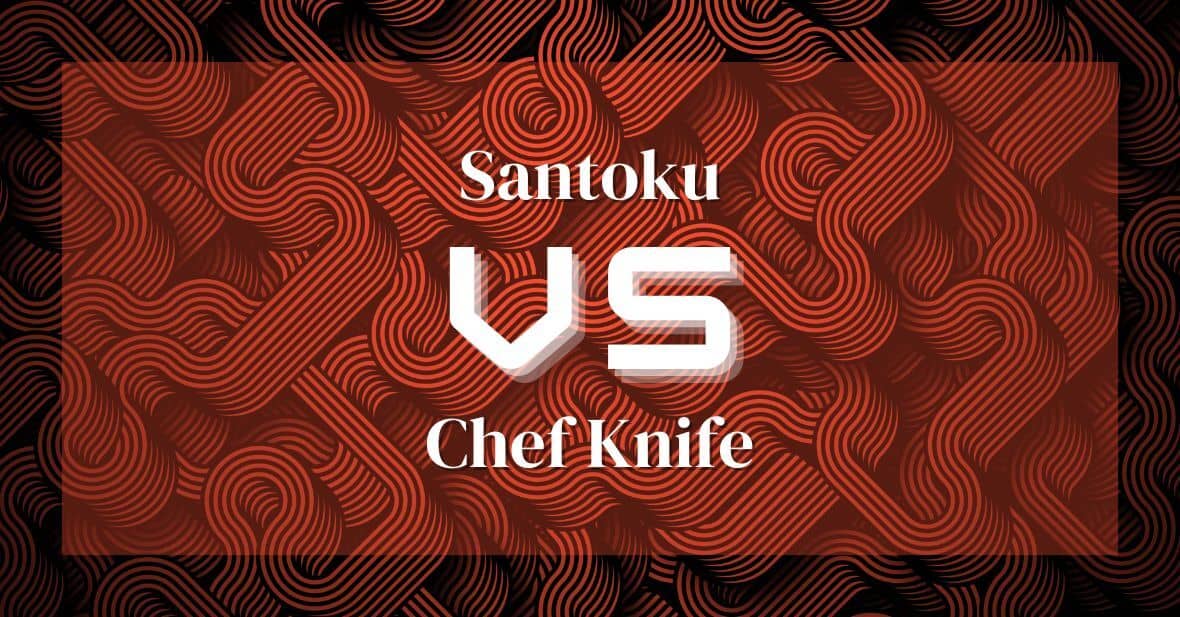Santoku Vs Chef Knife: The Ultimate Blade Showdown!
You could say that choosing between a santoku and the best chef knife is like picking your favorite ice cream flavor. There are so many options, but you just know that there is one that’s just right for you. Both of these knives have their own unique benefits and drawbacks, so it’s important to understand which one is best suited for your cooking needs.
In this article, we’ll compare the santoku to the chef knife by looking at:
- Blade length and width
- Weight and balance
- Blade shape
- Uses
- Care and maintenance
Get ready to make an informed choice on which type of knife will become your new kitchen companion!
Blade Length and Width
You want a blade that’s the right size for your needs – length and width make all the difference! When you’re choosing between a santoku or chef knife, it really depends on the size of blade you need.
A santoku has a shorter blade than a chef knife, usually measuring around 5 to 7 inches in length. On the other hand, chef knives typically measure 8 to 10 inches. Additionally, when it comes to width, chef knives are usually thicker than santoku blades.
The handle material and design is also important to consider as it will impact how comfortable and secure you feel while cutting with either knife type. Edge retention is another key factor in deciding which blade works best for you; both the santoku and chef knife offer great durability and longevity if they’re made from high-quality materials like stainless steel or carbon steel.
Weight and Balance
When it comes to weight and balance, you’ll want to consider how each tool feels in your hand – is it too heavy or too light? The santoku knife has a thinner blade than the chef’s knife, yet its slightly heavier design gives it greater control. This makes it ideal for slicing vegetables into thin slices.
However, if you’re looking for a knife that won’t tire out your wrist after extended use, the chef’s knife may be the better choice due to its lightweight design. Both knives have ergonomic handles that provide good grip comfort, but price can vary depending on material and brand.
Ultimately, finding the right weight and balance comes down to personal preference – so take some time to find the one that fits best in your hand.
Blade Shape
The shape of the blade can make a big difference in how the knife performs, so it’s important to choose one that fits your needs.
When comparing the santoku and chef knives, both have edge sharpness that is ideal for slicing vegetables and meat. However, the handle design of these two blades differs significantly.
The santoku has a flatter blade with a straighter edge, while the chef knife has a curved blade with an angled edge. This difference in design allows for more precise cutting as well as better maneuverability when performing tasks such as chopping and dicing foods.
As you can see, there are some distinct differences between these two types of knives that may be beneficial depending on your specific needs!
Uses
Both blades have their own unique uses, so it’s important to choose the one that best suits your needs.
The Santoku knife is a multi-purpose blade with versatile applications. It can be used for slicing, dicing, and mincing vegetables, as well as cutting meat and fish. Its shorter length makes it ideal for smaller hands or those who prefer a more compact knife.
On the other hand, the chef’s knife is great for larger tasks such as chopping through tough meats and large vegetables like squash or cabbage. It also has a curved edge which allows you to rock the blade back and forth when chopping herbs or garlic.
So whether you’re looking for something small and nimble or something big and powerful, there’s sure to be a knife that fits your needs!
Care and Maintenance
Caring for your knives is essential to ensure they last a long time and perform their best. After using your knife to chop up an onion, make sure you clean it thoroughly with warm soapy water and dry it off before storing it away.
Whether you have a Santoku or chef’s knife, sharpening techniques are also important for keeping them in good shape. It’s a good idea to use a honing steel regularly to realign the blade’s edge—just be careful not to over-sharpen them!
When it comes time for deep cleaning, soak your knife in warm soapy water overnight then hand wash with gentle soap and plenty of scrubbing action. Don’t forget to dry off the blade well afterward as moisture can cause damage over time.
Following these simple cleaning guidelines will make sure that both your Santoku and chef knives look as good as new!
Frequently Asked Questions
What is the difference between a Santoku and a Chef Knife?
Are you looking to take your cutting technique up a notch? If so, it’s time to consider the difference between a santoku and a chef knife.
Both knives are quality tools for slicing and chopping, but there are differences in their shape and size that can make or break the perfect cut. For example, santokus have thinner blades that may be better for making thin slices. On the other hand, chef knives have wider blades which are ideal for chopping through tougher ingredients like carrots or potatoes.
So when it comes to deciding between these two popular kitchen knives, think about the type of cuts you need to make – and choose wisely!
What is the best Santoku or Chef Knife for a beginner?
Choosing the best knife for a beginner can be overwhelming, but don’t worry! Whether you pick a santoku or chef knife, you’ll have the essential ingredients for success in the kitchen.
When selecting your new knife, make sure it feels comfortable in your hand and is made of quality materials that will last.
For top-notch maintenance, always sharpen your blade before each use and clean it after every meal prep session.
With careful selection and proper care, you’ll have a trusty companion to help with all of your culinary adventures!
How do I sharpen a Santoku or Chef Knife?
Sharpening your knife is essential for maintaining its quality and longevity. To sharpen a knife, you’ll need a honing steel, angle guide (optional), sharpening stone, and lubricant (water or oil).
Start by familiarizing yourself with the proper technique and angles for stropping your blade against the honing steel. Once you feel comfortable with that, move on to the sharpening stone to hone a finer edge.
Finally, wipe off any debris and apply lubricant to protect it from rust. With these simple steps in mind, you can keep your knives razor-sharp!
What is the best material for a Santoku or Chef Knife?
You may be wondering what kind of material is best for a santoku or chef knife. Well, the answer isn’t so cut and dry.
While both knives have similar uses, each one has its own set of advantages when it comes to materials. Edge retention is key when choosing a knife material, as this will determine how long your blade stays sharp and how often you’ll need to sharpen it.
On the other hand, if you’re looking for balance in your blade then stainless steel might be a better option than carbon steel. But don’t worry – no matter which type of knife you choose, there’s sure to be a material that fits your needs!
And with all these options available, you can find the perfect combination of edge retention and balance to make cooking meals more enjoyable than ever before.
How do I store a Santoku or Chef Knife safely?
Storing a knife safely is important for maintaining it. You don’t want to be caught off guard with a dull blade. First, make sure to clean the knife after use.
Then, store it away in an area where children can’t access it. Preferably, somewhere out of direct sunlight. If you have multiple knives, consider purchasing a knife block or sheath for each one. This will prevent them from rubbing against each other and getting damaged during storage.
Not only will this help your knives last longer, but it will also keep them safe from getting into the wrong hands!
Conclusion
When it comes to versatile kitchen knives, there’s really no contest. The Santoku knife is a clear winner over the chef’s knife, hands down.
It’s lighter, sharper, and more versatile – you can do pretty much anything with it! Plus, getting one with an ergonomic handle makes it so easy to use that you won’t believe how effortless your chopping and slicing become.
And don’t even get us started on the maintenance: You could be hit by a truck and your Santoku would still look like new!
If you’re looking for an all-in-one must-have in your kitchen arsenal, go ahead and treat yourself to a Great Santoku knife – you won’t regret it!

